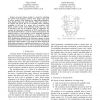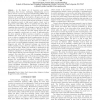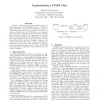195 search results - page 13 / 39 » Design of clocked circuits using UML |
SENSYS
2009
ACM
14 years 2 months ago
2009
ACM
Clock synchronization is highly desirable in many sensor networking applications. It enables event ordering, coordinated actuation, energy-efficient communication and duty cyclin...
DATE
2009
IEEE
14 years 2 months ago
2009
IEEE
—Accurate timing analysis is crucial for obtaining the optimal clock frequency, and for other design stages such as power analysis. Most methods for estimating propagation delay ...
DATE
2008
IEEE
14 years 2 months ago
2008
IEEE
— As the feature size of transistors gets smaller, fabricating them becomes challenging. Manufacturing process follows various corrective design-for-manufacturing (DFM) steps to ...
ICCD
1995
IEEE
13 years 11 months ago
1995
IEEE
STARI is a high-speed signaling technique that uses both synchronous and self-timed circuits. To demonstrate STARI, a chip has been fabricated using the MOSIS 2 CMOS process. In a...
ASPDAC
2007
ACM
13 years 11 months ago
2007
ACM
This paper presents a design methodology that was applied to the design of a 2.4GHz dual-core SPARC64TM microprocessor with 90nm CMOS technology. It focuses on the newly adopted t...



